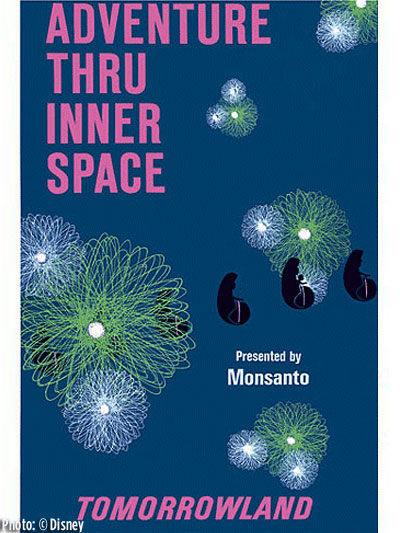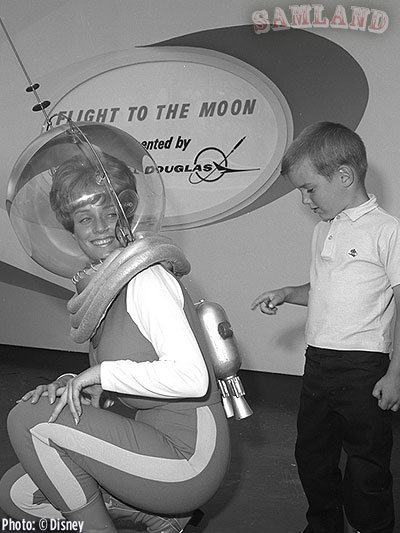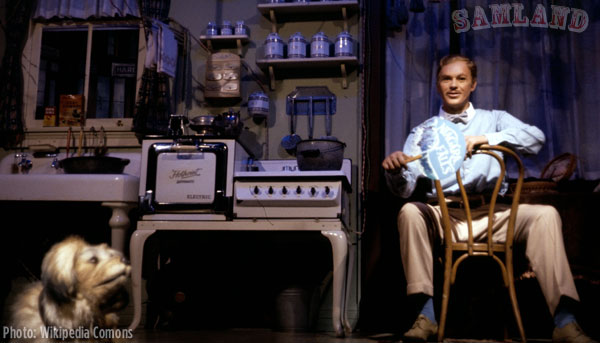So what was the most magical year at Disneyland? If you could go back and visit, which year would you choose? Would it be 1959 with a bunch of new attractions? Or 1963? Some would argue that the mid-1980s were the golden age. Maybe even today is the climax. Good game to play with others, eh?
A good candidate might be 1967. New Orleans Square and it’s a small world were still new. And the Park would open two major projects that Walt Disney was deeply involved with. Pirates of the Caribbean would set a new standard of showmanship. Tomorrowland would be reinvented and become A World on the Move. There is much to be said about Pirates but this time I am going to focus on Tomorrowland.
The dedication for Tomorrowland summed up Walt’s feelings. It said, “Science and technology have already given us the tools we need to build the world of the future. If we use the right now, we won’t have to wait to know what tomorrow will bring. I believe we will prove with new Tomorrowland that today IS the future.
New Tomorrowland ’67 covered five acres or the equivalent to more than four football fields. Cost of the project was approximately $20 million. The site plan was rather clever. The WED designers claim “a walk around the new Tomorrowland area — from door to door of each attraction — measures just one-half mile. This short walking distance is the result of careful positioning of the pavilions around a pivotal point (the PeopleMover station) without creating a “crowded” effect. Who thinks like this today?
That 85-foot tall central structure was known as the “theme” building with the Rocket Jets on top and the WEDway PeopleMover station on the second level. On the ground level was the Space Bar where guests could pick up a sandwich or a soft drink. The architecture for the entire area was described as “a study in pleasing textural contrasts” made of “uninterrupted surfaces [that] complement colorful, highly imaginative murals and sculptured panels of metallic veneer.”
The Rocket Jets were the adult version of Dumbo. Guests took one of two gantry elevators to the top level of the “theme” building. They board one of twelve jets and adjust the altitude with hydraulic pressure and compressed air for one and one-half minutes.
On the second level was the WEDway PeopleMover sponsored by Goodyear Tire and Rubber Company. The 58 constantly moving trains were boarded via a revolving turntable. The trains were pushed along by 500 motors embedded in the track. Guests could preview Tomorrowland and get a peek inside all of the shows and attractions. There was never a wait as the ride could handle a remarkable 4,800 guests per hour. There was even a V.I.P. Lounge located on the back side of the Plaza Inn.
The first of the new attractions was Adventure Thru Inner Space presented by Monsanto, the giant chemical company. There were 123 “Atomobiles” that would transport guests through the “Mighty Microscope” where they “appear to shrink beyond the size of a snowflake and journey into the universe of the atom.” Over the next six minutes they would encounter crystal like ice and enter “into the atom where the nucleus resembles a giant sun.” In August 1969, Cast Members were able to accommodate 35,583 guests in a 17 hour day. I am sure a celebration took place in the V.I.P. Guest lounge that was next to the loading area.
The Flight to the Moon presented by McDonnell Douglas was completely revamped. The attraction was divided into three experiences. Guests begin in Mission Control where they listen to Flight Control Director Dr. Tom Morrow, an Audio-Animatronics character, banter with a live Cast Member. This was a first. After the briefing, guests board one of the two 162-seat moon ships and feel the sensations of the pull of gravity and “weightlessness.” The journey through space would take twelve minutes.
The marquee attraction was the Carousel of Progress presented by General Electric. The show was one of the big hits at the 1964-1965 New York World’s Fair. At Disneyland, the show was installed in a 200-foot wide two-level circular structure with six 240-seat theaters mounted on a revolving platform. The platform revolved every 4 minutes. The building was decorated with a colorful, abstract mural.
The show takes guests “into the homes of four generations of the same family from the days before electricity to the present.” It featured 32 Audio-Animatronics “stars.” As the show came to an end, guests were invited to the second level to view the scale model of Progress City, “an entire community captured in capsulized realism.” The fully animated model was 6,900 square foot model and built at 1/8” to the foot. When the attraction opened, only women were allow to operate the show. There was also a V.I.P. Guest Lounge on the second level.
A new version of America the Beautiful debuted in the Circle-Vision 360 theater. While guests waited, they were entertained by one of the “attractive Bell Telephone” hostesses. All of the hostesses (yes, all women) worked for the Bell Telephone System and work at Disneyland from four to six months then back to their old jobs. The 12 minute show was presented with a new system using 9 synchronized, 35mm motion picture projectors and stereophonic sound broadcast through 19 speakers. The post-show area allowed for guests to play with the advance telecommunication displays including a speaker phone!
The Tomorrowland Terrace (called the Refreshment Gardens during development) presented by Coca-Cola was the place to be when it came time to eat or dance. WED designers created a “facility without exterior walls that would obstruct views of the always-moving panorama of Tomorrowland. Disneyland was rightly proud of the the infrared gas-fired conveyor-broiler that could prepare 1,500 hamburgers per hour. There was also a subterranean network of conveyors to take the bussing procedures out of sight. When it came time for the live entertainment, an modern oval planter rose from the ground level and it became a canopy for a stage. The canopy over the dining area would come alive with 450 tiny lights.
Also in 1967, the Disneyland-Alweg Monorail got four brand new Mark III trains. The five-car trains carried 127 guests on the 2.5 mile, 10-minute loop to the Disneyland Hotel and back. The Matterhorn was considered part of Tomorrowland, the Submarine Voyage was still taking guests under the North Pole, and the two Autopias were still running over the feet of Cast Members.
If you needed to buy some souvenirs you had three places to choose from. The Mod Hatter carried “way-out hats of every description.” The Character Shop, was the second largest store in the Park and carried a wide variety of merchandise. There was even a temporary souvenir stand located in Alpine Gardens.
In just twelve years, the Park had grown from 22 attractions to over 52. The initial investment of $17-million had grown to $95 million. More than $40 million was spent since 1964. The result is more than 60 million people had passed through the turnstiles since opening day.
Those guests have included 11 kings and queens, 26 presidents, prime ministers, and other heads of state as well as 36 royal princes and princesses. The U.S. State Department described the Park as “one of the nation’s greatest goodwill builders.” Visiting Disneyland was so popular with dignitaries, it was the second most requested destination after Washington D.C.
Not only has Disneyland prospered but Anaheim had also done okay. A new 9,100 seat Anaheim Convention Center opened with more than 200,000 square feet of display space. Anaheim Stadium, home of the California Angels recently opened. Grow in the hotel inventory was unprecedented. In 1955, there were 60 motel-hotel rooms in the Anaheim area. By 1967, there were 125 hotels and motels with more than 6,500 rooms within a five mile radius of the Park. The Disneyland Hotel had expanded to 610 guests rooms and a new 250-seat coffee shop had opened. There was a 9-hole golf course, a driving range, a miniature golf course, and an Olympic-size swimming pool.
Many of the traditions we know today were in place by 1967 including the annual Christmas parade, a giant New Year’s Eve Party, Grad Nights, and Summertime dance parties.
What is your favorite year?
Hard for me to believe but my upcoming book, THE DISNEYLAND THAT WAS, IS, AND NEVER WILL BE, is already available for pre-order.
THE DISNEYLAND THAT WAS, IS, AND NEVER WILL BE
A Biography of an American Institution
Walt Disney said, “Disneyland is the star. Everything else is in the supporting role.”The Disneyland that Was, Is, and Never Will Be is the story of how Walt Disney’s greatest creation was conceived, nurtured, and how it grew into a source of joy and inspiration for generations of visitors. Despite his successors battles with the whims of history and their own doubts and egos, Walt’s vision maintained momentum, thrived, and taught future generations how to do it Walt Disney’s way.









You must be logged in to post a comment.